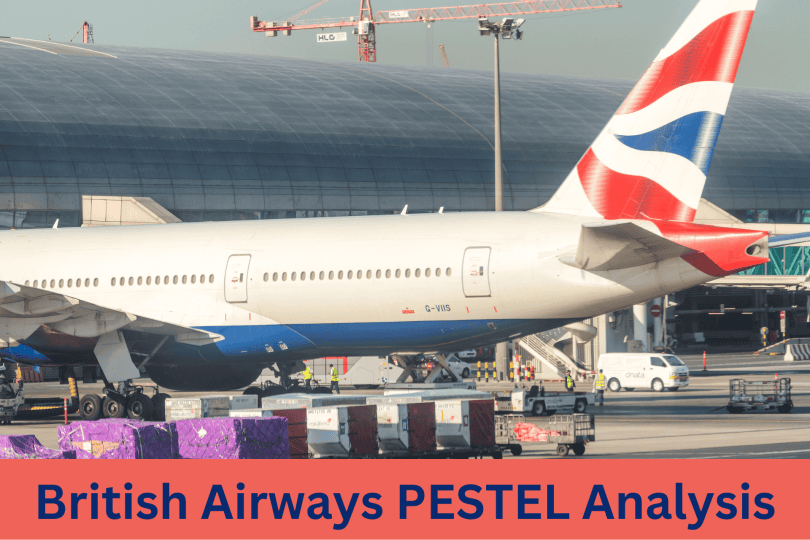The global airline industry is marked by its complexity, unpredictability, and inherent volatility, making it one of the most challenging sectors to navigate.
For an iconic carrier like British Airways, these challenges are magnified by the multifaceted and dynamic external environment in which it operates.
From fluctuating fuel prices and severe environmental regulations to evolving political landscapes and rapid technological advancements, the factors influencing the airline’s strategic decisions are both diverse and interconnected.
In such a turbulent context, a comprehensive PESTEL analysis becomes crucial. This analytical tool enables a deeper understanding of the Political, Economic, Social, Technological, Environmental, and Legal forces shaping the industry.
Complementing this with a SWOT analysis provides a holistic view of the strengths, weaknesses, opportunities, and threats that British Airways and its peers face in 2024, offering valuable insights into their strategies and resilience in a perpetually shifting global arena.
British Airways overview

British Airways is a giant in the commercial aviation industry, with a history that stretches back to 1919. Originally founded as Aircraft Transport and Travel Limited, it merged with British Overseas Airways Corporation (BOAC) in 1974 to become the flag carrier airline of the United Kingdom.
Interestingly, they hold the distinction of launching the world’s first international scheduled air service, a route connecting London and Paris.
British Airways offers a variety of services to its customers. It is a major player in passenger transportation, with both domestic and international flights to a vast network of destinations.
Beyond passengers, it also handles cargo transportation, facilitating the movement of goods across its global network. Additionally, British Airways caters to the complete travel experience by offering holiday packages that combine flights with accommodation and curated experiences.
The airline industry is fiercely competitive, and British Airways faces challenges from two main categories: major airlines and low-cost carriers.
Major airlines like Emirates, Lufthansa, Virgin Atlantic Airways, Singapore Airlines, and Qatar Airways compete by offering premium travel experiences and extensive global networks. On the other hand, low-cost carriers like EasyJet and Ryanair pose a threat by attracting budget-conscious travelers with their focus on affordability.
To maintain its position in this competitive landscape, British Airways relies on a network of key suppliers. Aircraft manufacturers like Airbus and Boeing play a critical role by providing the modern and efficient airplanes that form the backbone of the British Airways fleet.
Fuel suppliers, typically major oil and gas companies, ensure a steady flow of fuel to keep the planes in the air. Finally, collaborations with airport authorities around the world are essential for ground handling services, landing rights, and efficient airport operations.
British Airways caters to a diverse range of customers. Leisure travelers seeking a getaway or families embarking on vacations form a significant segment of the customer base.
Business travelers who need to attend meetings or conferences in different parts of the world also rely on British Airways’ extensive network. Additionally, cargo companies utilize British Airways’ freight services to move goods efficiently around the globe.
British Airways implements several strategies to stay ahead in the competitive airline industry. A key strategy is fleet modernization, which involves investing in new, fuel-efficient aircraft. This not only reduces operational costs but also minimizes environmental impact.
Additionally, they constantly evaluate and refine their route network to cater to changing travel demands and optimize their network. Finally, British Airways prioritizes customer focus, striving to enhance the passenger experience through improved in-flight amenities and services.
While exact figures may vary depending on the year, British Airways boasts a large fleet of airplanes, typically in the hundreds. As a major player in the industry, their annual sales figures are significant.
The airline’s network spans the globe, connecting passengers to destinations in over 70 countries, although this number can fluctuate.
Political factors
The political environment presents both current and potential opportunities for British Airways in the international airline industry. Here’s a breakdown of some key areas:
Opportunities:
Government Support:
Governments often provide financial aid or subsidies to airlines, particularly flag carriers like British Airways. This can offset operational costs and improve profitability.
For instance, In 2020, during the height of the COVID-19 pandemic, the UK government implemented a financial support package for airlines, including British Airways, to help them weather the crisis. This included loan guarantees and tax breaks.
Relaxation of Travel Restrictions:
As countries ease travel restrictions and testing requirements implemented during the pandemic, international travel demand is expected to rebound. This translates to increased passenger numbers and potential revenue growth for airlines like British Airways.
According to the International Air Transport Association (IATA), global passenger traffic is expected to reach 81% of pre-pandemic levels in 2024 and fully recover by 2025.
Focus on Sustainability:
Governments around the world are increasingly focusing on environmental regulations and sustainability initiatives. This can create opportunities for airlines that invest in fuel-efficient aircraft and sustainable aviation fuels (SAF).
For example, the European Union’s Emissions Trading System (EU ETS) is a cap-and-trade program that requires airlines to pay for their carbon emissions. Under this system, airlines that invest in cleaner technologies can reduce their costs.
Also, a study by McKinsey & Company estimates that the global market for SAF could reach $20 billion by 2030.
Trade Agreements:
Trade agreements between countries can lead to relaxed restrictions on air travel and cargo movement. This could benefit British Airways by opening up new routes and increasing cargo capacity.
For instance, the ongoing negotiations for a potential free trade agreement between the UK and the United States could lead to more streamlined air travel regulations between the two countries.
Infrastructure Development:
Government investment in airport infrastructure can lead to increased capacity and efficiency, potentially benefiting airlines by reducing delays and congestion.
The UK government’s plans to expand Heathrow Airport could create opportunities for British Airways to add new routes or increase frequencies on existing routes.
Threats:
The political environment also presents several current and potential threats to British Airways’ operations in the international airline industry.
Geopolitical tensions:
Geopolitical tensions and global economic fluctuations can lead to significant swings in fuel prices, which are a major expense for airlines. This can squeeze profit margins and force airlines to raise ticket prices.
The ongoing war in Ukraine has disrupted global energy markets, leading to a surge in oil prices. Jet fuel prices are closely linked to crude oil prices, and this increase has significantly impacted airlines’ operating costs in 2023 and 2024.
Government Intervention:
Governments can impose restrictions on air travel due to various reasons, such as public health emergencies, security concerns, or political disputes. These restrictions can disrupt flight schedules, reduce passenger numbers, and lead to financial losses for airlines.
For example, during the peak of the COVID-19 pandemic in 2020 and 2021, many governments implemented strict travel restrictions and border closures, leading to a near-collapse in international air travel. This had a devastating impact on airlines worldwide, including British Airways.
Taxation:
Governments can introduce or increase taxes on airlines, such as fuel taxes, passenger taxes, or airport departure taxes. This can increase operating costs and potentially lead to higher ticket prices for passengers.
The UK government’s Air Passenger Duty (APD) is a tax levied on passengers flying out of UK airports. This tax can add a significant cost to airline tickets, particularly for long-haul flights.
Protectionist Policies:
Governments may implement protectionist policies that favour domestic airlines over foreign carriers. This could limit British Airways’ ability to access certain markets or routes.
Some countries have “cabotage restrictions” that limit the ability of foreign airlines to carry passengers between domestic destinations within that country. This can limit British Airways’ growth potential in certain markets.
Political Instability:
Unrest or political instability in certain regions can dissuade travellers from visiting those areas. This can lead to a decline in demand for flights to those destinations, impacting airlines that operate routes in those regions.
For example, The ongoing political instability in some parts of Africa and the Middle East can discourage travellers from visiting those regions, impacting airlines that offer flights to those destinations.
Economic factors
The economic environment presents both exciting possibilities and significant challenges for British Airways in the international airline industry.
Opportunities:
Rebound in Travel Demand:
As economies recover from the COVID-19 pandemic, pent-up demand for travel is leading to a surge in passenger numbers. This translates to increased revenue potential for airlines like British Airways.
So, according to the World Travel & Tourism Council (WTTC), global travel and tourism spending is expected to reach 80% of pre-pandemic levels in 2024 and surpass pre-pandemic levels by 2025.
E-commerce Boom:
The growth of e-commerce creates huge opportunities for airlines to expand their cargo business. Airlines can leverage their global networks to transport goods efficiently across borders, catering to the increasing demand for online shopping fulfillment.
For instance, Global e-commerce sales are projected to reach $6.5 trillion by 2023, and the growth trajectory will continue in the coming years.
Emerging countries:
Economic growth in emerging markets can lead to increased disposable income, potentially fueling more travel spending and higher demand for premium travel experiences. This could benefit British Airways, which caters to both leisure and business travellers.
For example, the projected economic growth in India and China in the coming years could lead to an increase in travel demand from these regions, creating opportunities for airlines like British Airways.
Sharing Economy Platforms:
Partnerships with travel booking platforms and online travel agencies (OTAs) can help airlines reach a wider audience and potentially increase bookings.
Thus, collaborating with platforms like Expedia or Kayak can expose British Airways to a broader customer base and potentially lead to increased ticket sales.
Threats:
Fuel Price Volatility:
As mentioned earlier, fluctuations in fuel prices can significantly impact airlines’ operating costs. This can lead to reduced profitability or force airlines to raise ticket prices, potentially discouraging some travellers.
Global Economic Slowdown:
A global economic slowdown could decrease disposable income and lower travel demand, impacting airlines’ revenue.
For example, rising interest rates and inflation in some countries could dampen consumer spending on discretionary items like travel in the near future.
Labor Shortages:
The airline industry needs more qualified personnel, including pilots, cabin crew, and ground staff. This can lead to operational disruptions, flight cancellations, and increased labor costs for airlines.
The International Air Transport Association (IATA) estimates that the global aviation industry will need to recruit 4.4 million new workers by 2037 to meet projected demand.
Social factors
The social and cultural landscape presents both promising possibilities and serious threats for British Airways in the international airline industry.
Opportunities:
Growing Middle Class:
The expanding middle class in developing economies is creating a new generation of travelers with disposable income and a desire to explore the world. This translates to increased demand for air travel, potentially benefiting airlines like British Airways.
The World Bank estimates that the global middle class will reach 3.2 billion people by 2025.
Experiential Travel Trend:
Travelers are increasingly seeking unique and enriching experiences over traditional vacations. This opens up relevant opportunities for airlines to partner with destinations and offer curated travel packages that cater to this trend.
British Airways could collaborate with local tourism boards or adventure travel companies to offer unique travel packages that combine flights with cultural experiences, eco-tours, or off-the-beaten-path destinations.
Diversity and Inclusion:
Consumers are more conscious of diversity and inclusion practices. Airlines that demonstrate a commitment to these values by catering to diverse demographics and offering inclusive travel options can attract a wider range of passengers.
A study by McKinsey & Company found that companies that embrace diversity and inclusion outperform their less diverse peers financially.
Social media impact:
Social media platforms and travel blogs influence travel decisions. Airlines can leverage these platforms to engage with potential customers, promote travel destinations, and personalize their marketing strategies.
For example, British Airways can utilize social media to showcase new destinations, share customer travel experiences, and offer targeted advertising campaigns based on user preferences.
Sustainable Travel Practices:
Environmental consciousness is a growing concern for travelers. Airlines that prioritize sustainability by reducing their carbon footprint and offering eco-friendly travel options can appeal to environmentally conscious consumers.
British Airways could invest in carbon offset programs, offer travelers the option to purchase carbon credits, and promote their use of fuel-efficient aircraft to attract environmentally conscious travelers.
Evolving Customer Expectations:
Travelers expect a seamless and personalized travel experience. Airlines that invest in technology, offer flexible booking options, and prioritize customer service can gain a competitive edge.
For instance, British Airways could implement self-service kiosks for easier check-in, offer mobile boarding passes, and provide personalized travel recommendations to enhance the customer experience.
Focus on Sustainability:
Consumer interest in sustainable travel is growing. Airlines that invest in fuel-efficient aircraft and sustainable aviation fuels (SAF) can attract environmentally conscious travellers and gain a competitive edge.
A Deloitte study suggests that 43% of travellers are willing to pay a premium for sustainable travel options.
Threats:
Cultural Sensitivities:
Airlines need to be mindful of cultural sensitivities in different regions to avoid offending passengers or encountering negative publicity.
British Airways needs to ensure that its marketing materials, in-flight announcements, and staff training are culturally appropriate for the diverse range of passengers it serves.
Technological factors
The technological environment is rapidly transforming the international airline industry, presenting both exciting opportunities and significant challenges for companies like British Airways.
Opportunities:
Operational Efficiency:
Technological advancements like artificial intelligence (AI) and machine learning can optimize flight planning, manage fuel consumption, and streamline maintenance processes. This can lead to cost savings and improved operational efficiency for airlines.
For example, airlines can use AI to optimize flight paths based on real-time weather data, potentially reducing fuel consumption and flight times.
Customer Experience:
Technology can enhance the customer experience before, during, and after the flight. For instance, Mobile apps can allow passengers to check in, download boarding passes, and track their luggage.
Self-service kiosks can streamline check-in processes at airports, and in-flight entertainment systems can offer passengers a wider range of content and personalization options.
Personalization:
Airlines can leverage data analytics to personalize offers and marketing campaigns for individual passengers, potentially increasing customer satisfaction and loyalty.
British Airways could analyze customer travel history and preferences to offer personalized recommendations for destinations, upgrades, or travel insurance.
Autonomous Aircraft:
While still in the early stages of development, autonomous aircraft technology has the potential to revolutionize the airline industry. This could lead to reduced operational costs, increased efficiency, and potentially even new types of air travel services.
For example, Autonomous cargo drones could offer faster and more efficient delivery of goods over shorter distances.
Advanced Ticketing and Payment Systems:
Blockchain technology and other innovations can lead to more secure and efficient ticketing and payment systems. This could improve the customer experience and potentially reduce fraudulent transactions.
Advanced Training Simulators:
Virtual reality (VR) and augmented reality (AR) can create more immersive and realistic training simulations for pilots and cabin crew. This could enhance training effectiveness and potentially improve safety standards.
Threats:
Cybersecurity Threats:
Airlines are increasingly reliant on technology, making them vulnerable to cyberattacks. Data breaches or disruptions to critical systems can have a significant impact on operations and customer trust.
Integration Challenges:
Integrating new technologies into existing systems can be complex and expensive. Airlines need to invest in the necessary infrastructure and expertise to ensure smooth implementation.
A study by SITA found that 72% of airlines cite the integration of new technologies as a major challenge.
Digital Divide:
Not all travelers have equal access to technology. Airlines need to ensure that their digital solutions are inclusive and accessible to all passengers.
Some older passengers may not be comfortable using mobile apps for check-in or boarding. Airlines need to provide alternative options for these passengers.
Environmental factors
Opportunities:
Focus on Sustainability:
Growing public concern about climate change is driving demand for more sustainable travel options. Airlines that invest in fuel-efficient aircraft, sustainable aviation fuels (SAF), and carbon offset programs can attract environmentally conscious travelers and potentially gain a competitive edge.
A study by Airbus suggests that 70% of travelers are willing to pay a premium for sustainable air travel.
Regulatory Pressure:
Governments worldwide are implementing stricter regulations on aviation carbon emissions. Airlines that proactively invest in sustainable technologies can comply with these regulations and avoid potential penalties.
The European Union’s Emissions Trading System (EU ETS) is a cap-and-trade program that requires airlines to pay for their carbon emissions. Under this system, airlines that invest in cleaner technologies can reduce their costs.
Technological Advancements:
Developments in aircraft design and propulsion technologies like electric and hydrogen-powered aeroplanes can lead to significant reductions in carbon emissions in the long run.
Several companies are developing electric and hydrogen-powered aircraft, although they are still in the early stages of development.
Carbon Offsetting Programs:
Offering high-quality carbon offset programs can allow passengers to compensate for the environmental impact of their flights. This can attract environmentally conscious travelers and generate additional revenue for airlines.
Sustainable Airport Infrastructure:
Collaboration with airports to invest in sustainable infrastructure, such as renewable energy sources for ground operations, can further reduce the environmental impact of air travel.
Thus, airports can invest in solar panels or wind turbines to generate electricity for their operations, reducing reliance on fossil fuels.
Threats:
Climate Change Concerns:
The aviation industry is a significant contributor to greenhouse gas emissions, and public pressure to address climate change is growing.
Airlines that are not seen as actively working towards reducing their environmental impact could face reputational damage and potentially lose customers. The aviation industry is estimated to account for about 2.4% of global CO2 emissions.
Fuel Inefficiency:
Traditional jet fuel is a major source of carbon emissions. Until more widespread adoption of SAF or alternative technologies occurs, airlines will remain reliant on this high-emission fuel source.
So, the availability and affordability of SAF still need to be improved compared to traditional jet fuel.
High Costs of Sustainable Technologies:
Investing in new fuel-efficient aircraft or alternative technologies like SAF can be expensive for airlines. This can strain their finances and potentially slow down the transition to a more sustainable industry.
Legal factors
Opportunities:
Consumer Protection Laws:
Strong consumer protection laws can benefit airlines by fostering trust with passengers and creating a fair and predictable operating environment. This can ultimately lead to increased customer satisfaction and loyalty.
The European Union (EU) has strong consumer protection regulations for air travel, which ensures passengers have certain rights in case of flight cancellations, delays, or lost luggage.
Clarification of Regulations:
Clear and consistent legal frameworks regarding areas like drone technology or passenger data privacy can provide airlines with a more predictable regulatory landscape.
Upcoming regulations on drone usage in international airspace could clarify operating guidelines and reduce potential safety concerns for airlines.
Standardization of Regulations:
Efforts to harmonize international aviation regulations can simplify compliance for airlines operating across multiple jurisdictions, potentially reducing administrative burdens and costs.
The International Civil Aviation Organization (ICAO) works to establish global standards for air travel safety and security. Increased cooperation between ICAO and national regulatory bodies could lead to further standardization.
Legal Advocacy:
Airlines can engage in legal advocacy to influence the development of regulations that are fair and balanced, promoting both safety and economic growth in the industry.
Threats:
Litigation:
Airlines can face lawsuits from passengers for various reasons, such as flight cancellations, injuries sustained during travel, or lost baggage. These lawsuits can be costly and time-consuming to defend and can impact the airlines’ reputation.
A study by Airline Weekly found that airlines in the US alone faced over 12,000 lawsuits related to passenger issues in 2022.
Labor Disputes:
Disputes with labor unions over wages, benefits, or working conditions can lead to strikes or other disruptions that can significantly impact airline operations.
Recent strikes by ground staff at several major airlines have caused flight cancellations and delays, impacting passengers and airline finances.
Evolving Regulatory Landscape:
The constant evolution of regulations in areas like safety, security, and emissions can create uncertainty and compliance challenges for airlines.
The upcoming implementation of the EU’s Fit for 55 package could require European airlines to make significant investments in new technologies to comply with stricter emission reduction targets.
British Airways PESTEL analysis summary
| Factors | Opportunities | Threats |
|---|---|---|
| Political | ✓Government support and subsidies ✓Relaxation of travel restrictions ✓Focus on sustainability initiatives ✓Trade agreements opening new routes ✓Infrastructure development | ✓Geopolitical tensions impacting fuel prices ✓Government intervention and travel restrictions ✓Increased taxation on airlines ✓Protectionist policies favoring domestic carriers ✓Political instability deterring travel |
| Economic | ✓Rebound in travel demand post-pandemic ✓Growth in e-commerce boosting cargo business ✓Rising disposable income in emerging markets ✓Partnerships with travel booking platforms | ✓Fuel price volatility affecting operating costs ✓Global economic slowdown reducing travel demand ✓Labor shortages leading to operational disruptions |
| Social | ✓Growing middle class increasing travel demand ✓Trend towards experiential travel ✓Emphasis on diversity and inclusion ✓Leveraging social media for engagement ✓Demand for sustainable travel practices | ✓Need for sensitivity to cultural differences. |
| Technological | ✓AI and automation for operational efficiency ✓Enhanced customer experience through technology ✓Personalized marketing using data analytics ✓Development of autonomous aircraft ✓Blockchain for secure ticketing and payments ✓Advanced training simulators | ✓Cybersecurity threats ✓Challenges in integrating new technologies ✓Digital divide among travelers |
| Environmental | ✓Investment in sustainable aviation fuels (SAF) ✓Compliance with environmental regulations ✓Advancements in low-emission aircraft ✓Offering carbon offset programs ✓Collaboration on sustainable airport infrastructure | ✓Public pressure on aviation’s environmental impact ✓Reliance on high-emission jet fuel ✓High costs of adopting sustainable technologies |
| Leagal | ✓Consumer protection laws fostering trust ✓Clarification of drone and data privacy regulations ✓Standardization of international aviation regulations ✓Legal advocacy influencing fair regulations | ✓Litigation from passengers ✓Labor disputes causing operational disruptions ✓Constantly evolving regulatory requirements |
Conclusion
This PESTEL analysis of British Airways underscores the complex and ever-changing macro environment that this UK company navigates within the international airline industry.
Despite opportunities such as economic recovery, an expanding middle class, and technological advancements, the airline also faces significant challenges, including fuel price volatility, geopolitical tensions, and shifting customer expectations.
To leverage these opportunities and address the threats, British Airways should diversify its revenue streams by enhancing cargo operations, ancillary services, and strategic partnerships with travel platforms.
Hedging fuel cost fluctuations is crucial for economic resilience. The airline should also tap into the growing middle-class markets with culturally sensitive travel packages and aim to lead in sustainable travel by investing in fuel-efficient technologies and carbon offset programs.
Technological innovation is essential, with a focus on AI and automation to improve operations and customer experience, and partnerships for autonomous aircraft development.
It is vital to prioritize customer-centric strategies, such as mobile technology, for seamless travel and personalized marketing. Additionally, sustainability leadership through investment in sustainable aviation fuels, alternative aircraft technologies, and ambitious carbon neutrality goals will help British Airways navigate its complex environment and maintain its competitive edge.
Read also: British Airways SWOT analysis in 2024.
PESTEL analysis examples 2024
To better understand the PESTEL analysis, we invite you to read our recent free examples of the Pestel framework.
PESTEL analysis of Primark
Click here to read our example of Primark’s PESTEL analysis.
PESTEL analysis of Zara
Click here to read our example of Zara’s PESTEL analysis.
PESTEL analysis of DHL
Click here to read our example of DHL’s PESTEL analysis.
PESTEL analysis of FedEx
Click here to read our example of FedEx’s PESTEL analysis.
PESTEL analysis of Chipotle
Click here to read our example of Chipotle’s PESTEL analysis.
PESTEL analysis of Brazil
Click here to read our example of Pestel’s analysis of Brazil.
PESTEL analysis of Spotify
Click here to read our example of Spotify Pestel analysis.
Chick-fil-A PESTEL Analysis
Click here to read our example of Chick-fil-A Pestel analysis.
Costco PESTEL Analysis
Click here to read our example of Costco Pestel analysis.
Microsoft PESTEL Analysis
Click here to read our example of Microsoft Pestel analysis.
Disney PESTEL Analysis
Click here to read our example of Disney Pestel analysis.
Airline Industry PESTEL Analysis
Click here to read our example of the Airline industry Pestel analysis.
Walmart Pestel Analysis
Click here to read our example of Walmart Pestel analysis.
Amazon Pestel Analysis
Click here to read our example of Amazon Pestel analysis.
McDonald’s Pestel Analysis
Click here to read our example of the Netflix Pestel analysis.
Netflix Pestel Analysis
Click here to read our example of the Netflix Pestel analysis.
Apple Pestel Analysis
Click here to read our example of the Apple Pestel analysis.
Twitter Pestel Analysis
Click here to read our example of the Twitter Pestel analysis.
Facebook Pestel Analysis
Click here to read our example of the Facebook Pestel analysis.
Pestel analysis of the Social Media industry
Click here to read our example of the Pestel analysis of the Social Media industry.
Ikea Pestel Analysis
Click here to read our example of the IKEA Pestel analysis.
Tesla Pestel Analysis
Click here to read our example of the TESLA Pestel analysis.












Leave a Comment